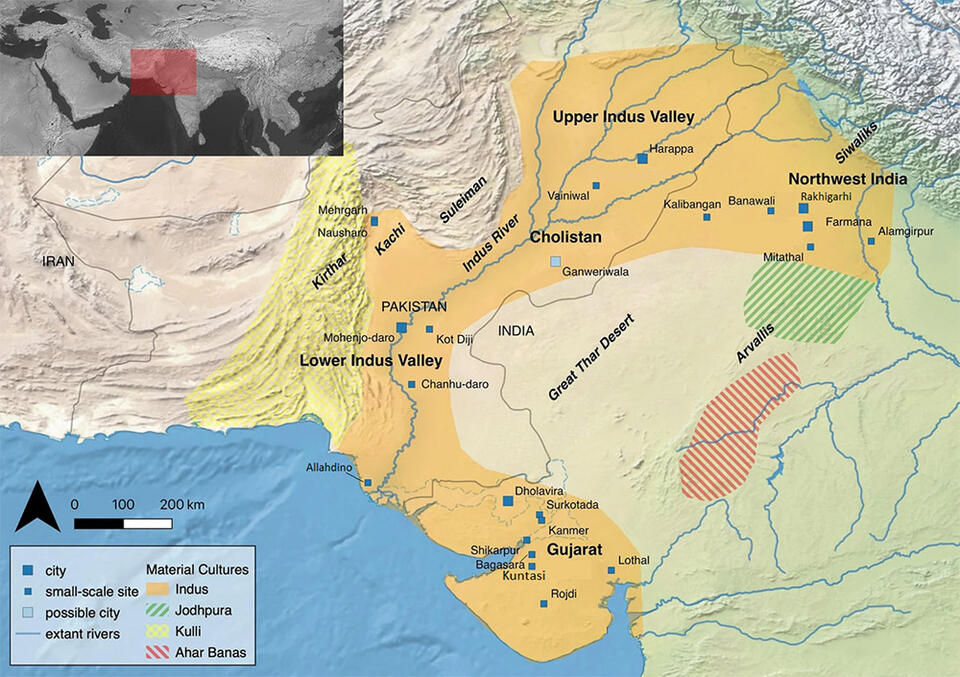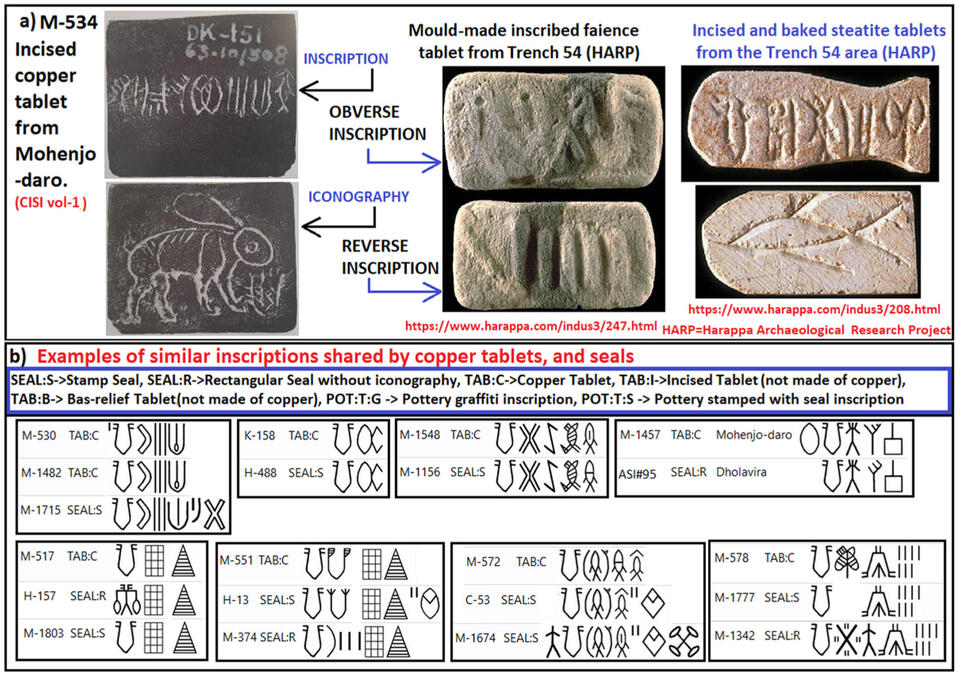The author brings together a great deal of information to argue that "inscribed stamp-seals were primarily used for enforcing certain rules involving taxation, trade/craft control, commodity control and access control," and in relating stamp seals and tablets, that "such tablets were possibly trade/craft/commodity-specific licenses issued to tax-collectors, traders, and artisans," (p. 1). Mukhopadhyay uses her in-depth analysis, facilitated by complex and useful charts, to also argue that "the inscriptions did not encode any proper noun, such as anthroponyms, toponyms, or names of specific organizations," (p. 1). Her focus is on the administrative, economic uses of seals. It certainly seems as if evidence from elsewhere would back up the perspective that writing and inscribed or written communication to begin with had a lot to do with business, labor, permission and procedure.
"This study analyses various script-internal and archaeological evidence, and concludes that IVC’s inscribed seals/sealings/tablets were primarily used for encoding certain administrative rules and regulations for (i) controlling the cultivation/manufacturing/ trading of certain commodities; (ii) collecting taxes and issuing licenses for specific commodities and commercial activities; (iii) exerting access control; etc.," (p. 3) writes Mukhopadhyay. It is very helpful that she begins by going over other interpretations and why they have gotten nowhere despite a century of effort, and how names of people and places have played a big role in ancient Egyptian, Cunieform and Linear B scripts. She objects particularly to Parpola's interpretation of the fish and potential numerical lines that accompany them. Instead she discusses the similarity of signs across more than 600 years, the multiple languages that likely were present just like today, and many other points to move towards a more crop-livestock sign reading which, one might say, seems very reasonable in the sense that certain signs do indeed look like crops and crops and goods were part of other ancient agricultural sign systems.
There is also good argument to be had in the regulation of the craft of seal production in particular, select materials sizes and conventions, that could link it to regulation and rule-encoding, like trade or custom rights, or protection or taxation. The animals, real and imaginary on most seals, are discussed in a convincing manner: "The seal-iconographies, most of which were animal-centric (bull, goat, “unicorn”, tiger, elephant, scorpion, etc.), most possibly functioned as different seal-issuing organizations’ emblems. Interestingly, various Indian tribes, clans, and septs have often been named after animals since antiquity. For example, Vedic texts record various animal-based ethnonyms, such as “Mahāvṛṣa” (big bull), “Aja” (goat), “Matsya” (fish), etc. (Macdonell and Keith, 1912 a, b). Similarly, several South- Indian tribal sub-clans have been using animal-centric names such as “Bhāg” (tiger), “Puli” (tiger), Nāg (snake), Mēkala (goat), Cēli (goat), Āne (elephant), Jinka (gazelle), Adu (sheep), Thelu (scorpion), etc. (Thurston, 1909). Besides, many of the punch-marked coins of early-historic India, also used similar zoomorphic iconographies (“tiger”, “elephant”, “bull”, “pea- cock”, etc.), as insignias of their issuing clans and dynasties (Kosambi, 1996/1956). For example, certain punch-marked coins issued by the Mauryan dynasty, contained the iconography of a “peacock on arches”, arguably signifying the Mauryan clan-name “Moriya,” which meant “of the peacock” (Kosambi, 1996/1956)," (p. 15).
Thinking of the feeding trough next to so many animals to depict a "'tax-receiving' entity" (p. 17) may seem to be pushing it, but it does show up for many animals, particularly on the bison/gaur Massimo Vidale has discussed so well as common in so many seals found in Mesopamia and the Gulf. The relationship to trade licenses and permits a century ago in the west points to the complexities and need for simplicity in these documents or "stamped" papers not unlike the clay sealing impressions on different good bags we know from the archaeological record. "Indus systems of taxation and trade-control were complex enough to need writing," (p. 27).
The many diagrams in the article, with sign sequences and combinations by site and context including object they relate to, especially from Harappa and Mohenjo-daro, are really worth pondering. They help novice and expert think about what these signs may have meant in the performative economy where they subsisted and would have encoded a set of practices. The fine distinctions that were likely made through the signs and their derivatives speak to the same level of sophistication we see in the sanitation, jewelry, trade and manufacture from the period. The map used at the beginning (Image 1, above) of the article, adapted from Adam Green, is also nice in reminding us of the context, cultures to the west (Kulli) and East (Ahar Banas, Jodhpura) between which Indus civilization sprung up and flourished.
Highly recommended as a thought-provoking, internally consistent paper. It may not completely capture what seems to also be a talismanic, personal role that seals may also have had for their owners and users, the great but disposable value they seem to have held for a period of time (but not after death). Nonetheless, clearly seals and their signs were the tentacles of a complex, multi-layered economic and social system. This paper describes well how this might have worked.
Images: 1. A map of the Indus civilization along with some of its contemporary neighboring material cultures, showing certain Indus sites selected from the sites mentioned in this article. The map is adapted with permission of Adam Green from Figure-1 of Green (2021), which is covered by the Creative Commons Attribution 4.0 International License.
2. Similarities between the inscriptions of Indus seals and tablets. Panel a shows examples of different types of Indus tablets. Panel b shows examples of certain seals and copper tablets containing identical or similar inscriptions.




